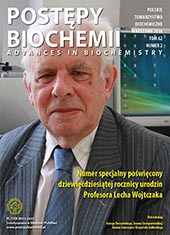Annexins in mitochondria
Abstract
Annexins form a family of membrane- and calcium-binding proteins, widely distributed in vertebrates. Their interactions with membranes are regulated by changes of intracellular concentration of calcium ([Ca2+]in.), pH, and the presence of negatively charged phospholipids as well as cholesterol in membranes. As protein participating in membrane fusion and sensors of a [Ca2+]in. Annexins may regulate various signaling pathways including patways involving protein kinase C (PKC isoforms. They also particpate in membrane repair mechanisms (along with actin cytoskeleton and S100 protein), in the vesicular transport (cholesterol enriched domains) as well in in intracellular calcium homeostasis and regulation of mitochondrial function and mitochondrial network structure. The last possibility is a topic of present review commemorating 90th Birthday of Professor Lech Wojtczak.
Downloads
Published
Issue
Section
License
All journal contents are distributed under the Creative Commons Attribution-ShareAlike 4.0 International (CC BY-SA 4.0) license. Everybody may use the content following terms: Attribution — You must give appropriate credit, provide a link to the license, and indicate if changes were made, ShareAlike — If you remix, transform, or build upon the material, you must distribute your contributions under the same license as the original. There are no additional restrictions — You may not apply legal terms or technological measures that legally restrict others from doing anything the license permits.
Copyright for all published papers © stays with the authors.
Copyright for the journal: © Polish Biochemical Society.




